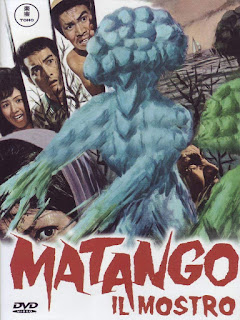Matango
Matango, also known by its English translation titles Attack of the Mushroom People and Fungus of Terror, is a decidedly interesting horror film from Ishiro Honda, the director who gave the world Godzilla. As with his better known work, Honda fits serious themes into a horror / sci-fi premise, using this story of a group of people stranded on an island with a serious fungal issue into a metaphor for various societal ills, including the class divide and drug abuse.
Matango is based on the William Hope Hodgson short story "The Voice in the Night," in which the narrator encounters a shipwrecked man who has fallen victim to fungi on a deserted island. Honda remains faithful to the basic concept of the story, adapting it to film by removing the narrator and concentrating on the people stranded on the island rather than the lone survivor. The film follows the survivors of a ship that was damaged during a storm and runs aground on a desert island. The castaways include the ship's skipper, a rich man, a college professor, his student, a writer, and an aspiring pop singer. They think they've had a stroke of luck when they find another ship that has run aground and contains ample food supplies. However, the stranded ship is covered with a strange mold as well as a samples of an odd mushroom labeled "Matango." Although the castaways initially try to avoid the mushrooms, as food grows scarce and tensions build, their resolve starts to weaken and they find the mushrooms addictively delicious.
Honda diverges from the original story by focusing more on the interpersonal drama between the survivors. The castaways gradually start to turn on one another, driven by class divisions and romantic entanglements. The skipper clashes with the rich man who owns the ship over who should be in charge, while the rich man and the writer fight over their love for the pop singer. The ship's sailors similarly start to turn against the skipper, who thinks he can still command them despite the ship being wrecked. These interpersonal conflicts set the stage for the castaways' downfall, as the writer rebels by starting to eat the Matango mushrooms, which grow all over the island. Adding to the tensions, our characters encounter odd, deformed people walking around the island and even on the ship. Could these mysterious figures and the mushrooms be linked?
Along with exploring class issues, Honda uses the film as a metaphor for drug addiction, with the castaways continuing to eat the mushrooms even after they become aware of their dangerous effects on people. The disfigured "mushroom people" parallel the effects of using hard drugs such as heroin. The film has a suitably grim atmosphere, with a dark, decaying shipwreck as the main setting and an equally moody forest on the island providing the scene for the climax. It also features a memorably grim denouement, particularly when one considers that the English dub of Matango, Attack of the Mushroom People, was often advertised on Saturday afternoon UHF television as typical kiddy matinee sci-fi.




Comments
Post a Comment